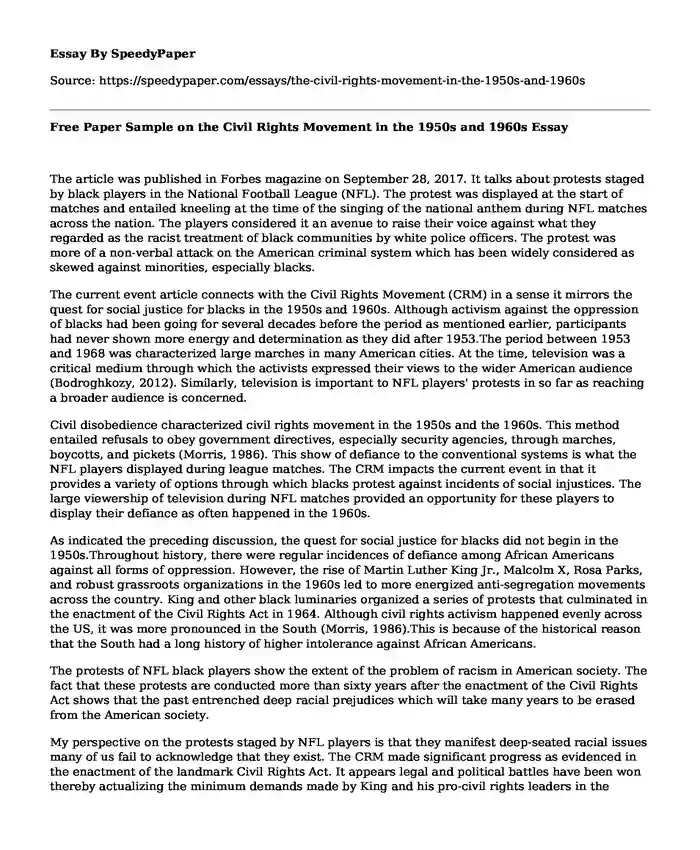
| Type of paper: | Article review |
| Categories: | Civil rights |
| Pages: | 3 |
| Wordcount: | 653 words |
The article was published in Forbes magazine on September 28, 2017. It talks about protests staged by black players in the National Football League (NFL). The protest was displayed at the start of matches and entailed kneeling at the time of the singing of the national anthem during NFL matches across the nation. The players considered it an avenue to raise their voice against what they regarded as the racist treatment of black communities by white police officers. The protest was more of a non-verbal attack on the American criminal system which has been widely considered as skewed against minorities, especially blacks.
The current event article connects with the Civil Rights Movement (CRM) in a sense it mirrors the quest for social justice for blacks in the 1950s and 1960s. Although activism against the oppression of blacks had been going for several decades before the period as mentioned earlier, participants had never shown more energy and determination as they did after 1953.The period between 1953 and 1968 was characterized large marches in many American cities. At the time, television was a critical medium through which the activists expressed their views to the wider American audience (Bodroghkozy, 2012). Similarly, television is important to NFL players' protests in so far as reaching a broader audience is concerned.
Civil disobedience characterized civil rights movement in the 1950s and the 1960s. This method entailed refusals to obey government directives, especially security agencies, through marches, boycotts, and pickets (Morris, 1986). This show of defiance to the conventional systems is what the NFL players displayed during league matches. The CRM impacts the current event in that it provides a variety of options through which blacks protest against incidents of social injustices. The large viewership of television during NFL matches provided an opportunity for these players to display their defiance as often happened in the 1960s.
As indicated the preceding discussion, the quest for social justice for blacks did not begin in the 1950s.Throughout history, there were regular incidences of defiance among African Americans against all forms of oppression. However, the rise of Martin Luther King Jr., Malcolm X, Rosa Parks, and robust grassroots organizations in the 1960s led to more energized anti-segregation movements across the country. King and other black luminaries organized a series of protests that culminated in the enactment of the Civil Rights Act in 1964. Although civil rights activism happened evenly across the US, it was more pronounced in the South (Morris, 1986).This is because of the historical reason that the South had a long history of higher intolerance against African Americans.
The protests of NFL black players show the extent of the problem of racism in American society. The fact that these protests are conducted more than sixty years after the enactment of the Civil Rights Act shows that the past entrenched deep racial prejudices which will take many years to be erased from the American society.
My perspective on the protests staged by NFL players is that they manifest deep-seated racial issues many of us fail to acknowledge that they exist. The CRM made significant progress as evidenced in the enactment of the landmark Civil Rights Act. It appears legal and political battles have been won thereby actualizing the minimum demands made by King and his pro-civil rights leaders in the 1960s. However, the social aspect of racial prejudice still lingers. The players may have achieved nothing in their decision to kneel when the national anthem is played, but their show of defiance reminds us of the need to have a more open conversation about racial prejudice in America.
References
Bodroghkozy, A. (2012). Equal time: Television and the Civil Rights Movement. Champaign: University of Illinois Press.
Morris, A. D. (1986). The origins of the Civil Rights Movement (2nd ed.). New York: Simon and Schuster.
Zaldivar, G. (2017, September 28). The worst thing NFL players can do right now is stop kneeling. Forbes.
https://www.forbes.com/sites/gabezaldivar/2017/09/28/the-worst-thing-nfl-players-can-do-right-now-is-to-stop-kneeling/#43b3f2264e1d
Cite this page
Free Paper Sample on the Civil Rights Movement in the 1950s and 1960s. (2022, Mar 23). Retrieved from https://speedypaper.net/essays/the-civil-rights-movement-in-the-1950s-and-1960s
Request Removal
If you are the original author of this essay and no longer wish to have it published on the SpeedyPaper website, please click below to request its removal:
- Free Essay Sample on Sanders Resort
- Essay Sample: Mini-Management Plan for Cyber Software
- Essay Example on Marine Law
- Free Essay Describing a Meeting with the Head of Faculty of Mulberry State University
- Free Essay: Marijuana and Its Effects on Young Adults among Society Today
- Essay Sample on Social Justice Movement in American History
- Paper Example - Intersectionality and Women's Leadership
Popular categories




